#Gaussian distribution
Text
Known at the time as "the law of error", the formulation derived from the analysis by the German mathematician Carl Friedrich Gauss of errors made in the measurement of "true" physical quantities – for example, planetary positions in astronomy.
"In the Name of Eugenics: Genetics and the Uses of Human Heredity" - Daniel J. Kevles
#book quote#in the name of eugenics#daniel j kevles#nonfiction#law of error#formulation#derived#analysis#gaussian distribution#carl friedrich gauss#errors#measurement#astronomy
0 notes
Photo

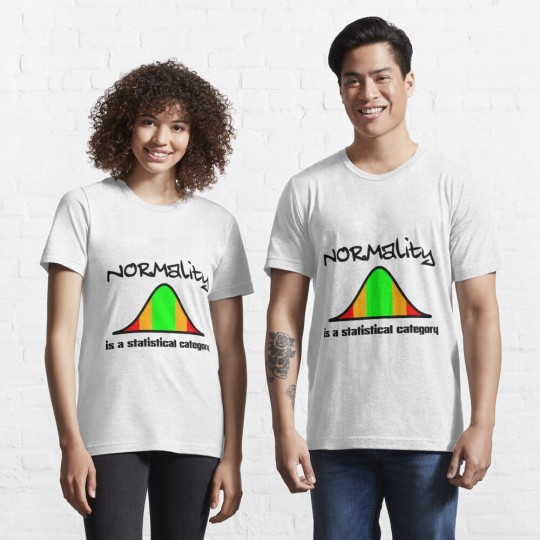
(via Normality is a statistical category Essential T-Shirt by djomla88)
#findyourthing#redbubble#gaussian distribution#statistics#gauss#normality#normal distribution#bell curve#science#philosophy#difference#be different#tolerance#empathy
0 notes
Text
since we're now back on tour with both, i'd like to know the kääryboo distribution on tumblr six months after eurovision
explain in the tags if it's changed since eurovision or if it's still the same, or if you have some other sort of funky relationship with the fandom(s)
#käärijä#joker out#poll#a#i'm expecting either kä heavy or gaussian distribution#but i may be very surprised
94 notes
·
View notes
Text
still thinking about “la curva (kurwa) di Gauss!”
#it’s shaped like a boob…#‘i gave you a 3 because at a 4 i can do it and at a 5? god.’#if i was still in a statistics class i would reference this when talking about gaussian distribution#txt#andrzej sapkowski
6 notes
·
View notes
Text
Consider how dumb the average person is,
Now consider that means half the population is dumber than that
Now consider that there are so many axes by which we can measure intelligence that it suffers the curse of dimensionality, ergo the population is distributed along the surface of a high-dimensional hypersphere and while the average normalized magnitude of any point's intelligence is 1, the mean of all points would be at the origin (re: 0), so maybe think about that and treat people with more dignity and kindness
1 note
·
View note
Text
There is no such thing as AI.
How to help the non technical and less online people in your life navigate the latest techbro grift.
I've seen other people say stuff to this effect but it's worth reiterating. Today in class, my professor was talking about a news article where a celebrity's likeness was used in an ai image without their permission. Then she mentioned a guest lecture about how AI is going to help finance professionals. Then I pointed out, those two things aren't really related.
The term AI is being used to obfuscate details about multiple semi-related technologies.
Traditionally in sci-fi, AI means artificial general intelligence like Data from star trek, or the terminator. This, I shouldn't need to say, doesn't exist. Techbros use the term AI to trick investors into funding their projects. It's largely a grift.
What is the term AI being used to obfuscate?
If you want to help the less online and less tech literate people in your life navigate the hype around AI, the best way to do it is to encourage them to change their language around AI topics.
By calling these technologies what they really are, and encouraging the people around us to know the real names, we can help lift the veil, kill the hype, and keep people safe from scams. Here are some starting points, which I am just pulling from Wikipedia. I'd highly encourage you to do your own research.
Machine learning (ML): is an umbrella term for solving problems for which development of algorithms by human programmers would be cost-prohibitive, and instead the problems are solved by helping machines "discover" their "own" algorithms, without needing to be explicitly told what to do by any human-developed algorithms. (This is the basis of most technologically people call AI)
Language model: (LM or LLM) is a probabilistic model of a natural language that can generate probabilities of a series of words, based on text corpora in one or multiple languages it was trained on. (This would be your ChatGPT.)
Generative adversarial network (GAN): is a class of machine learning framework and a prominent framework for approaching generative AI. In a GAN, two neural networks contest with each other in the form of a zero-sum game, where one agent's gain is another agent's loss. (This is the source of some AI images and deepfakes.)
Diffusion Models: Models that generate the probability distribution of a given dataset. In image generation, a neural network is trained to denoise images with added gaussian noise by learning to remove the noise. After the training is complete, it can then be used for image generation by starting with a random noise image and denoise that. (This is the more common technology behind AI images, including Dall-E and Stable Diffusion. I added this one to the post after as it was brought to my attention it is now more common than GANs.)
I know these terms are more technical, but they are also more accurate, and they can easily be explained in a way non-technical people can understand. The grifters are using language to give this technology its power, so we can use language to take it's power away and let people see it for what it really is.
12K notes
·
View notes
Text
i must say my body pain is a lot better since ending accutane but theres still these lingering effects that are annoying the fuck out of me since they wont go away. like yeah i can walk without limping again but my hip pain is still JUST ENOUGH that i cant walk without being painfully aware of the fact that i am walking. i can walk with zero heel pain again except when i stand up after a long time then i can feel my heels in pain again. like im not as absolutely bowled over by this anymore but its still present and its annoying as fuck like just go away already
#brot posts#then again this is also how the pain started - just little annoyances that i could power through without much effort#so maybe it’ll be the last thing to go then#gaussian distribution of pain intensity like this is just it fizzling out now#anyway besides all that my wrist is flaring up#which is separate from all this bc my wrists were the one thing my accutane shit never affected#so rn my wrist is actually the worst pain in my whole body not my hips or ankles#but its still so annoying to have to walk around with so many braces and wraps on me#my hip pain does get worse when i dont wear my brace so im like well maybe then i should wear it !!#maybe its helping me heal better !!#but its so annoying to wear it in conjunction with my wrist brace
0 notes
Text

Thank you @cobbbvanth for asking me for this; I’ve never been more flattered! ☺️ I’ve only been making gifs for a little more than 2 years, so I’m really still only figuring Photoshop out, and my colouring owes everything to other people’s tutorials (some of which can be found here). To be honest, I was only asked some tips, but I have no clue what to include and what to leave out; so, here’s my complete (if random) colouring process.
NOTE: This is a colouring tutorial, not a gif-making one. The tutorial that taught me everything I know about that (and to which I am eternally grateful) is this one by @hayaosmiyazaki.
I. SHARPENING
My standard sharpening settings are:
One Smart Sharpen filter set to Amount: 500 | Radius: 0,4
A second Smart Sharpen filter set to Amount: 10 | Radius: 10
One Gaussian Blur filter set to Radius: 1,0 and Opacity: 30%
One Add Noise filter set to Amount 0,5 | Distribution: Gaussian
II. BASIC COLOURING
This is the part where I add most of the adjustment layers available and just play around with them. Obviously different settings work for different scenes, but I do have some standard ones.
Brightness/Contrast
I usually up the Brightness to +10-30, and the Contrast to about +10.
Curves
For the first Curves layer I go to Auto Options > Enhance Brightness and Contrast, and then adjust the opacity until I’m happy.
I might repeat the above step if the gif still looks too dark to me.
I add another Curves layer, I go to Auto Options and this time I pick either Find Dark & Light Colors or Enhance Per Channel Contrast, and check or uncheck the Snap Neutral Midtones option, until I see something I like. I will then adjust the opacity.

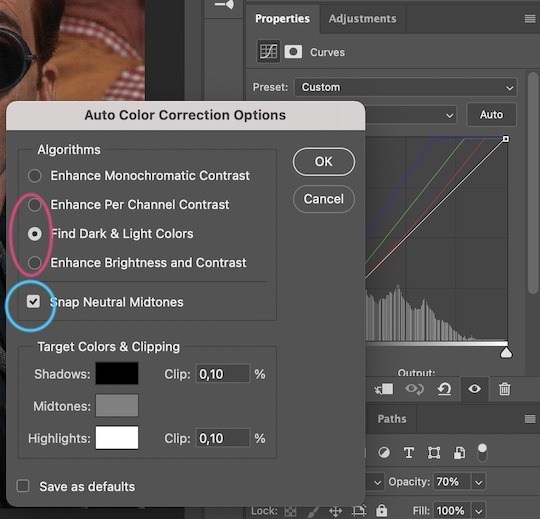
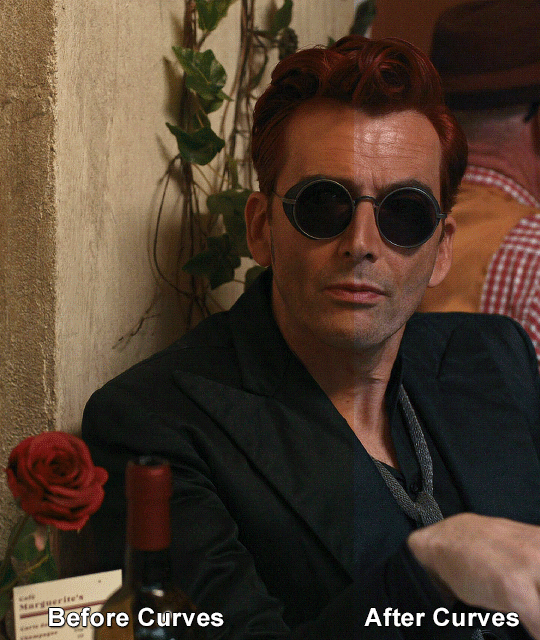
Levels
I add a Levels layer that usually looks something like this:
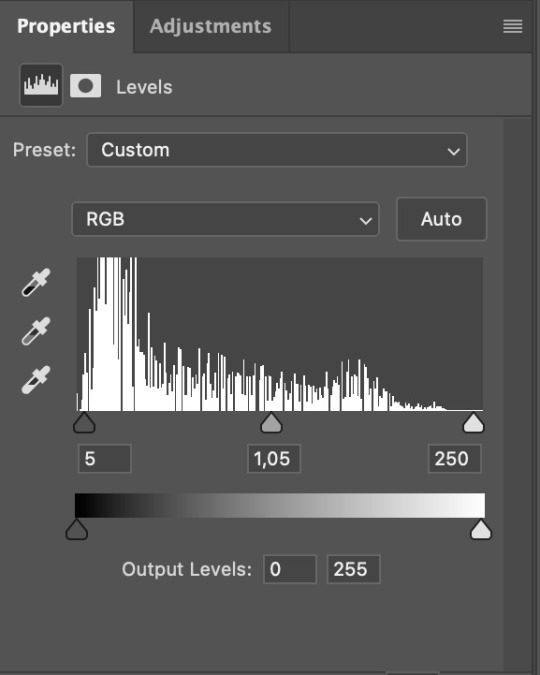
Exposure
I add an Exposure layer, where I usually set the Offset to around -0,0010.
Selective Color
To make the faces look okay, I create a Selective Color layer, select the Reds and usually add some Cyan (+10-20%) and play around a little (±5%) with Magenta and Yellow too. I might also add another layer, select the Yellows and make slight tweaks there too.
III. FUN COLOURING
About colour manipulation: PiXimperfect just uploaded a tutorial that explains everything so much better than I ever could, so I highly recommend you go watch it. It’s made for static images though, and things are more complicated with moving images, so I also recommend @elizascarlets’s tutorial.
The reason I usually go for a softer colouring is that a more vivid one requires a lot of patience and precision, and I honestly can’t be bothered. Instead, I try to tweak the colous only a little, so that the edges can be a little rough without it looking too wrong.
One thing to remember is that each gif is different, and there isn’t one foolproof way to do this, so you will need to use a different technique depending on the gif you’re working with.
Okay, so, after I’ve decided what colour I want my background to be:
1. I create a Hue/Saturation layer and change the greens, cyans, blues and magentas to that colour. That’s easy enough, since it doesn’t mess with the face colour. I then set the blending mode to Color. If your background doesn’t include any yellow or red, you might be done here, like in the case bellow:
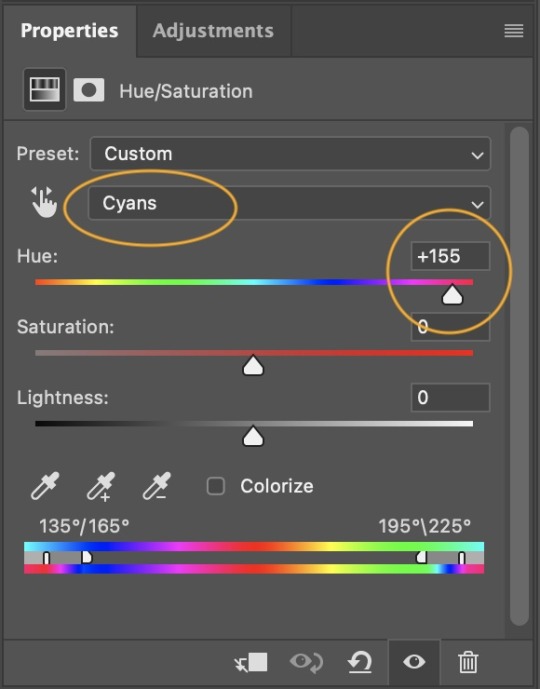
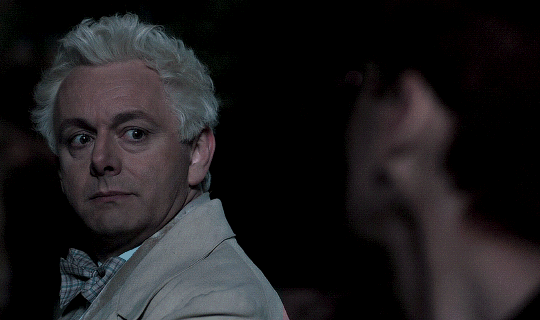
2. To change the yellows and reds, I create a new Hue/Saturation layer, select the yellows/reds, move Saturation to 100 (temporarily) and then play around with the sliders until the face colour isn’t affected. I then change it to whatever I’ve chosen and change the blending mode to Color.
3. If for whatever reason step 3 doesn’t work (the background is white or black for example, or just too red), I might create a Solid Color layer set to whatever colour I want, set the blending mode to Color and then select the layer mask and carefully paint with a soft, black brush over the people’s faces/bodies. I will then lower the Opacity, to whatever looks smooth enough. If there’s a lot of movement in your gif, you might have to use keyframes (see elizascarlets’s tutorial linked above). However, my main goal is to avoid using those; that’s why I try my hardest to tweak around as many Hue/Saturation layers as needed and not have to create a solid color layer.
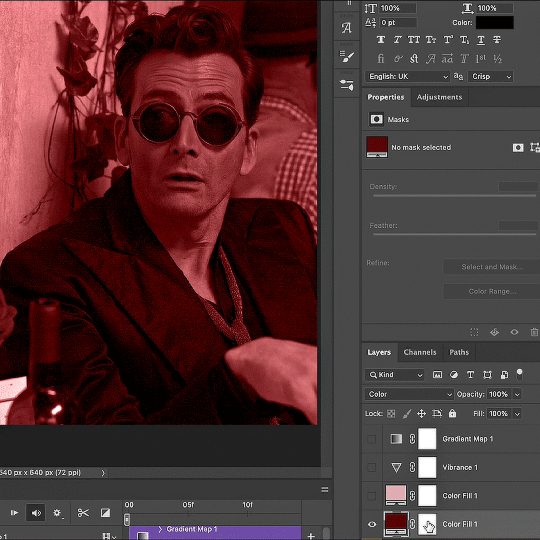
4. Once my background looks the colour I want it, I might add a Selective Color layer that matches my background color and then try to make it look more vibrant. For this Aziraphale gif below for example, I’ve selected the Cyans and then set Cyan to +100%, Yellow to -100% and Black to +60, then created another one, selected the Cyans again and then set Cyan to +20 and Black to +20.
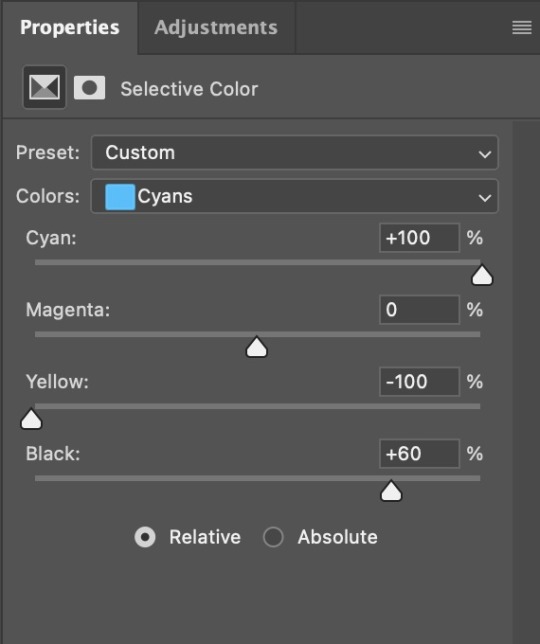
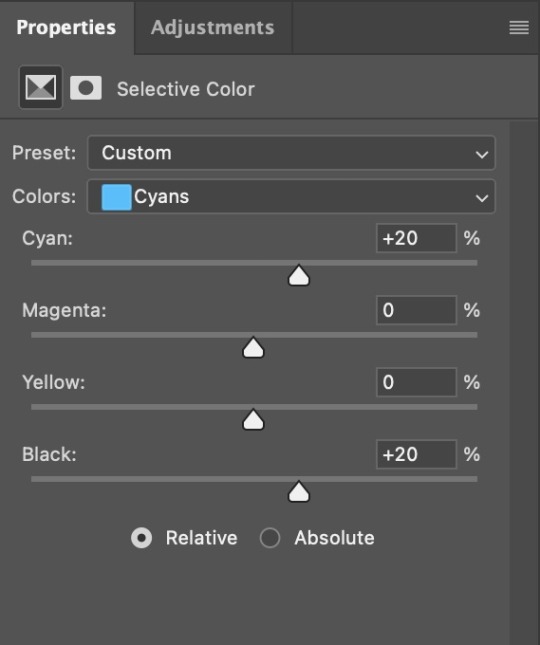
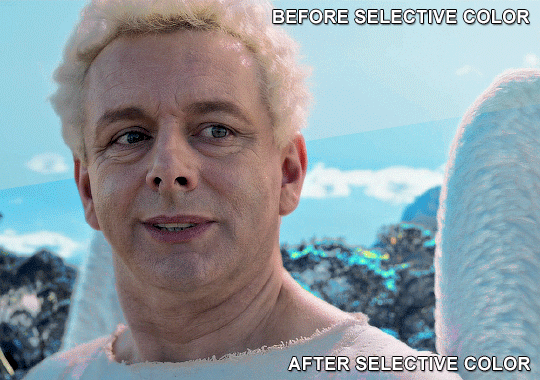
5. If the gif has a white area, I create a Solid Color layer with a colour that matches the rest of the background and then set the Opacity low. I might also create a Selective Color layer, increase the Black and then play around with the colours.
IV. FINISHING TOUCHES
I create a Vibrance layer and set the Vibrance to around +30 and the Saturation to about +5.
I create a black and white Gradient Map layer (with black on the left end of the spectrum and white on the right), set the blending to Luminosity and the Opacity to about 20-30%.
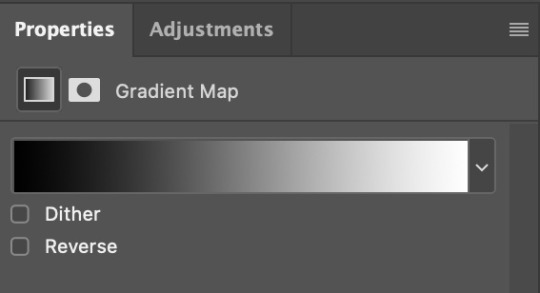
AAAND that’s about it I think! This ended up way too long and perhaps a little incoherent. I tried to make it as general as possible, so you might have to mix and match for best results. Feel free to ask me for further explanations about any one of these steps, and please tell me if you want me to go through the colouring of a specific gifset (although, as I said, I'm by no means an expert). Happy gifmaking!
#gif tutorial#allresources#completeresources#dailyresources#photoshop tutorial#minee#tutorial#tutorial*#chaoticresources#uservivaldi#userdanahscott#usersanshou#userfanni#userbuckleys#userrobin#tuserjen#userdavid#userzaynab#tusermimi#thingschanged#tuserju#usertj#userhallie
323 notes
·
View notes
Note
How do you simulate a championship, actually? (Your post really made me curious ab it lol) Do you like go through all the possible points and positions each driver can get in these last 11 races and then calculate the probability or something?
Yes! So I only calculated Lando and Max’s possible places saying that Lando’s average placing would be P2 and Max’s P3 accounting for the fact that the McLaren is the fastest car. I then used a Gaussian distribution centered on 2 and 3 respectively with a standard deviation of 2 to give me race results, made sure they weren’t placing in the same result, and transferred that to points and then a points difference. I then calculated that points difference over 10 races and 3 sprint races and determined whether the difference was overcome for Lando to win the championship! I then ran the simulation 10 million times and calculated how often Lando won, which was 4.33% of the time.
Of course you could poke countless holes in my simulation, it doesn’t take into account fastest lap point (mostly because I figured the likelihood of one getting it would be equal to the likelihood of the other getting it so they cancel out), nor does it account for possible DNFs or grid penalties, and I could run it with a greater standard deviation for Max considering Red Bull seem less reliable at the moment. But all in all, I think it’s robust enough for what we needed to figure out!
95 notes
·
View notes
Note
Hello! You've probably heard this a billion times but after searching around on your blog without much luck I thought I'd ask: how do you create the sort of slightly hazy, grainy 'anime'-esque overlay/filter in your pieces? I love how it looks like a hand drawn cel or a shot from an 80's animated film - 'impeccable vibes' as the kids would say 😁. Keep up the gorgeous work, I always adore seeing your OCs on my dash ❤️☺️
Hey! Thank you so so much!
I add a Noise filter on top of the art when I'm done. Sometimes I find a noise overlay to add on (the clip studio asset store has a bunch), but when I'm not feeling lazy I do it in Photoshop because I like the results best. Here's how:




You can change the amount of noise to whatever you think looks best. Most of the time I set the distribution to Uniform, but sometimes I do Gaussian too.
Hope this helps and that you enjoy your TV fuzz!
123 notes
·
View notes
Note
Hello !! Sorry if this has been asked before :(( I love how your posts look and was wondering how u edit them if you don’t mind sharing <3 I’m loving your posts so much 💌
Hi there! This hasn't been asked before and I've been meaning to finally do this. PS I don't do a ton of editing it's all reshade and psd actions (before and afters under the cut!
crop image to desired size (i like using ratio 7x9)
use the "smooth sharp(no topaz)" action from here
use the "super smooth" action from here
use the "add on: richness" action from here (adjust intensity)
use the "bright and saturated" action from here (adjust intensity)
Add Noise (settings amount: 2.5% distribution: gaussian)
Add Dust (I layer these patterns and change them to soft light or overlay)
bam- you're done!


36 notes
·
View notes
Photo

(via What is normality? Art Print by djomla88)
#findyourthing#redbubble#tshirt#print on demand#statistics#math#normality#morality#ethics#gaussian#gaussian distribution#stickers#canvas
0 notes
Text
is that a 3d analogue of a gaussian distribution graph in ur pants or are u just happy to see me

168 notes
·
View notes
Note
is there anyway you can share how you get a nice balance of contrast in your edits? they are super lovely!
thank you! <3
as a baseline whenever i start editing i usually duplicate the original gif layer, add gaussian blur, and set it to soft light. the amount of blur and opacity depends on the brightness and colours of the footage/image. on top of that, i lower the contrast with a brightness/contrast layer. then add some slight brightness with a curves layer. sometimes, if i want it to be even more soft overall, like in the example i added, i'll also duplicate the gaussian blurred soft light layer and set it to screen and mess around with the opacity again.
that kind of adds a subtle softer, more evenly distributed level of contrast across the entire image, at least in my opinion. it makes it easier to work with selective colour later to darken the blacks, if i need/want to, without muddying the whole thing as much.
of course, it depends on what i'm colouring. for pretty much all of my bg3 (and gaming or animation in general) gifs i do this, but for live action i don't really; i tend to just use brightness/contrast and levels.
i'm not the best at explaining because i usually just wing it LOL i don't know what i'm doing 99% of the time. the only thing guaranteed is i always struggle to get the gifs down to less than 10mb
i dont know if this is really an example of what you meant by contrast, but i had a psd of this gif saved so i thought i'd add it as a visual example of what i tend to do





20 notes
·
View notes
Note
A point a friend on discord made was
People with "mild" variations are often invalidated when they call themselves intersex and attacked, and not all people feel safe saying they are intersex for that reason and end up saying they are perisex. A term between the two would help with the safety of those people who do not feel safe and who are often forced to be put in a position they are not in.
Not all people with mild variations consider themselves intersex. However, they are not considered perisex because they have variations in sex.
Not everyone likes to use intersex. This is because they may find it very medicalizing (and sometimes the person has a variation in visible sex, but does not fit or does not want to see it fit into any medical term) or they may find it not medicalizing at all (some people really have problems with their sexual variation, causing disabilities, for example, and prefer to use more medical terms that define this). So, for those who feel that intersex is too medicalizing a term, you may prefer to use alternative terms
I'm the asker about spectrum and I wanted to let you know these points
Also. When I think about intersex as a spectrum, I meant in the linguistic/conceptual aspect. As like graysexual is in the asexual spectrum.
Myself, my intersex variation isn't studied yet (partial or mild EIS). And mesosex resonates with me. Even though in the end I could go with just being a dyadic ally or questioning/quoisex/extersex. I also feel as if like both the terms perisex and intersex could fit me
Some people also say sex is a statistically bimodal spectrum. What do you think about it?
Thanks for sharing! I'm glad the term mesosex resonates with you 😄 It's honestly really useful to hear from people who feel the term mesosex resonates with them. I put the word out there because I had a sense there's a demand but as somebody who feels solidly intersex I feel honestly weird having a say in a label I don't myself use.
If you didn't see it already, a mesosex person chimed into the original thread.
To me intersex is the anti-medicalizing term, especially in contrast to DSD, which to me is 100% medicalized. But that's just me!
Analogies about Biological Sex
So you also asked about my thoughts on sex as a "statistically bimodal spectrum", and the short answer is I think the term bimodal is misleading and possibly circular, and there are better analogies out there.
I already agree with what others have pointed out about sex not being a spectrum - a spectrum has one dimension (a line), and sex has dozens of dimensions (chromosomes, hormones, etc). Out of the analogies I've seen, I like most Hans Lindahl's train tracks analogy for sex development.
But I'm gonna guess that by "sex as a statistically bimodal spectrum" you mean "sex as a statistically probability distribution/density" and take this as something distinct from the sex-as-spectrum model.
As it turns out, I have a lot to say about "bimodal"
In my experience, people tend to have huge misconceptions about what statistically bimodal means. It understandably gets conflated a lot with the idea that there are two separate populations.
So let's think about height. People will say things like "height is bimodal" because they're conditioned to think that men and women are separate, and the average man is taller than the average woman.
And when they say things like "height is bimodal" they think the distribution for adults will look like this:

But here's what the adult human height distribution looks like:

The thing about normal/Gaussian distributions is that adding them together is tends to result in something that also looks normal/Gaussian.
If we look back at pink and blue distributions I hand drew, there's a visual sleight of hand going on there. Where the area under the curve is pink or blue, we can think of one pixel as representing one human in the data set. But in the part where they overlap, it's not one pixel per human, its one pixel for two humans - one from the womens' data set, one from the men's data set.
The result is that the size of the overlap looks half as small as it should be. It leads people to mistakenly think there is less overlap between men and women than there actually is.
So if we actually take that overlap and show how the distributions add together, we get something that immediately stops looking so "bimodal":

With the two probability distributions that I drew there might be a small dip in the middle, but it would be quite small. 🙃
Two probability distributions need to be really far apart for them to produce something that actually looks bimodal. (Specifically, the difference between the means needs to be smaller than twice the standard deviation - details here.)
True bimodal distributions are rare. They do exist in nature. But most of the time when people see a probability distribution with two peaks, it is a result of misleading visuals, noisy data, or poorly-binned histograms. 👀
In grad school I was taught that bimodality is a sign your data is suspicious: "Statisticians are trained to be suspicious of distributions with multiple modes. Such distributions usually indicate inhomogeneity in the system, or, in plainer language, different causes for the different modes. All familiar proverbs about the inadvisibility of mixing apples and oranges apply." (Gould, 1981)
In particular, the misinterpretation of (apparently) bimodal data has been used to confirm eugenicist ideas about racial differences, because when it comes to statistics we're always a step or two away from having to grapple with the legacy of eugenics. ⚠️
So let's get back the original question about seeing sex as statistically bimodal. The average person understands bimodal to mean "two populations", not statistical bimodality.
So before I even get into what sex even is, right off the bat this analogy is dangerously circular: sex is what it is because it's two separate populations.
Sex in humans is determined by a whole bunch of things that tend to correlate with each other (chromosomes, SRY gene, androgen levels, androgen sensitivity, estrogen levels, estrogen sensitivity, etc), so I can see the desire to illustrate that some things co-occur together more than others!
But I agree with @queercripintersex in the discussion of your previous ask that trying to project the multiple dimensions of sex into one dimension loses too much information, and is difficult to even do because so many factors are non-continuous (chromosomes, etc).
For the continuous variables, you can in theory try to find out if they have bimodal probability distributions. But quite rapidly run into issues of poor data. The data on testosterone levels in women is shockingly insufficient. Like I went looking for distributions of free testosterone levels and just look at how much noisier and sparse the data is for women (on the left) compared to men (on the right):
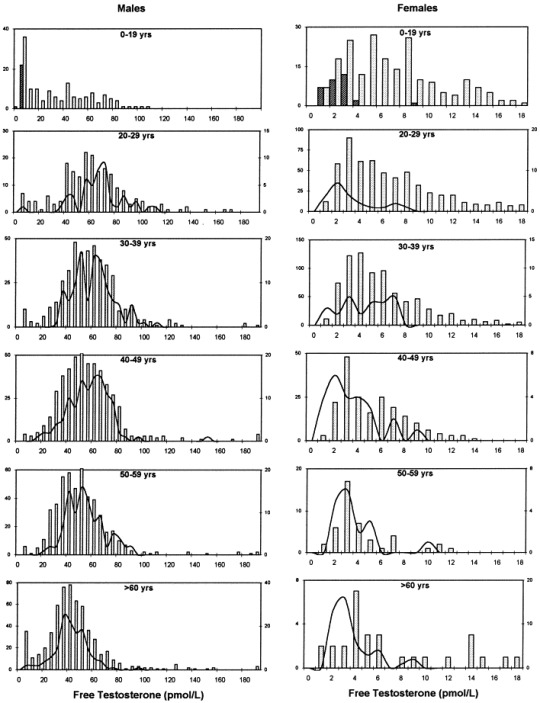
Source: Ooi et al, 1198
Even with all the noise in the data it's still unlikely that at any of the age categories, that the men's data and women's data added together would produce bimodal distributions. There's too much overlap.
As a general rule of thumb, any given physical difference (hormones, measurements, etc) has more variation within the sexes than between them.
Our culture has vastly overestimated the biological differences between the sexes. 😫 So I worry that adopting a sex-as-bimodal-distributions analogy will only feed this misconception. 🫤 I'm personally going to avoid using the analogy.
#sorry this is so long#but you asked an academic so this is what you get haha#eugenics: it's always there#biology of sex#biology education#science education#statistics education#text#intersex#mesosex#actuallyintersex#actually intersex
34 notes
·
View notes